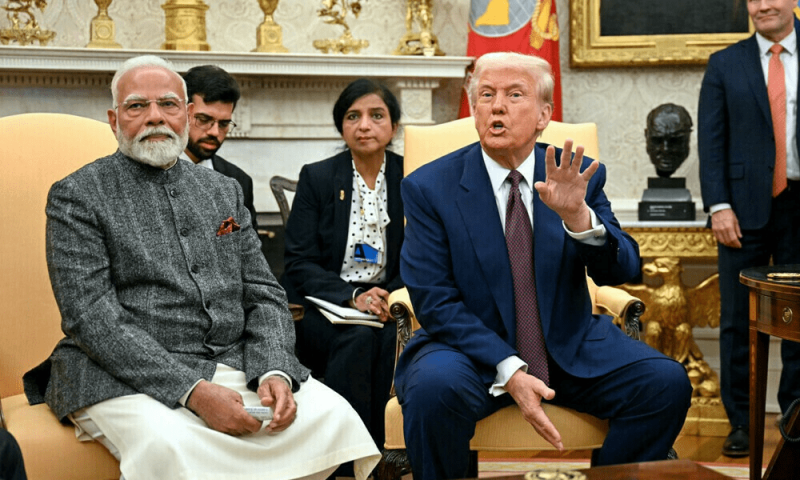At the start of this year, relations between India and the United States appeared to be on an upward trajectory. In February, just a month after Donald Trump’s return to the White House, Prime Minister Narendra Modi stood alongside his long-time friend at the White House, pledging to raise bilateral trade to $500 billion by 2030 and signalling the possibility of a comprehensive trade agreement.
This bonhomie wasn’t restricted to just trade – it reflected on defence cooperation, energy trade, and the Indo-Pacific security framework. Modi invited Trump to India for the planned Quad leaders’ summit later this year, a gesture intended to cement the personal rapport between the two leaders.
That optimism began to unravel in May when tensions between India and Pakistan flared dangerously. In a brief but intense escalation, Pakistan claimed to have shot down six Indian fighter jets and destroyed a BrahMos missile storage facility in Indian-Illegally Occupied Jammu and Kashmir. Both sides came perilously close to wider conflict before agreeing to a ceasefire on May 10.
Trump publicly took credit for brokering the deal, calling it a personal diplomatic success. India, however, disputed that narrative, insisting it was a mutually agreed arrangement without US mediation. This disagreement planted the first seeds of mistrust.
In June, the unease deepened when Trump invited Pakistan’s army chief, Field Marshal Asim Munir to the White House for a high-profile lunch.
The meeting, followed by announcements of a favourable US-Pakistan trade arrangement, an oil reserve development deal, new cooperation on cryptocurrency regulation, and Washington’s acceptance of Pakistan’s long-standing demand to designate the Balochistan Liberation Army and its Majeed Brigade as terrorist organisations, signalled a strategic warming between Washington and Islamabad.
Days before the Trump-Munir meeting, Modi and Trump held a tense phone call on June 17. According to reports, the conversation further soured their relationship, unravelling years of carefully built goodwill.
The economic blow
By August, the rupture had translated into hard measures. Trump slapped 25% tariffs on Indian imports, accusing New Delhi of maintaining “strenuous and obnoxious” trade barriers.
Days later, he doubled the rate to 50%, the highest for any Asian partner, citing India’s continued purchases of Russian crude as undermining the US sanctions regime against Moscow. He ruled out further negotiations until India cut its Russian oil imports.
This escalation came despite five rounds of talks toward an interim trade deal, in which India had shown willingness to increase US energy and defence purchases and lower tariffs on American industrial goods. Political miscalculations and disagreements over agricultural norms and quotas ultimately doomed the talks, leaving $190 billion in annual trade and a $46 billion deficit unresolved.
The tariff hike threatens India’s $87 billion export engine to the US, 18% of its total exports and over 2% of its GDP. Industry experts warn of a 40-50% drop in shipments, especially in labour-intensive sectors such as textiles, jewellery, and automobiles. Small and medium-sized enterprises face a severe loss of competitiveness, while economists have trimmed GDP growth forecasts by as much as 1%.
Market reaction has been swift: a weaker rupee, the risk of imported inflation, capital flight by foreign portfolio investors, and higher borrowing costs for foreign-currency debt.
Strategic fallout
The dispute undermines New Delhi’s ambitions in the Indo-Pacific. While the foreign ministers of Australia, Japan, the US, and India recently met in Washington, the Quad leaders’ summit now looks unlikely. Instead, India risks drifting closer to Russia, its long-time defence partner, and even exploring limited engagement with China, which Modi is set to visit later this month.
For Washington, this marks a reversal of a 25-year strategy of building up India as a counterweight to China’s rise. For New Delhi, it is a reminder of the volatility of personal diplomacy: the same leader who embraced Modi in Ahmedabad in 2020, before 100,000 cheering spectators, is now wielding tariffs as leverage.
Political setback for Modi
Domestically, the rupture is damaging for Modi. His image as a global statesman, reinforced by his perceived closeness to Trump, has been a key part of his appeal to India’s middle class. The opposition Congress party has seized the moment, branding him “Narendra Surrender” for failing to protect Indian trade interests. Even Hindu nationalist groups in the US, once among Trump’s staunch supporters, feel abandoned by Washington’s turn.
With his Bharatiya Janata Party (BJP) having lost its parliamentary majority in the last election, Modi now faces questions about his handling of both foreign and economic policy. His perceived inability to counter China’s assertiveness while losing favour in Washington could become a central vulnerability.
The stakes
At stake is more than just a trade dispute. The episode jeopardises three decades of India’s economic ascent and its strategic positioning as an emerging power backed by a US partnership.
Whether this moment leads to strategic drift, realignment toward other powers or eventual rapprochement with Washington will shape India’s trajectory for years to come.
The above article was contributed by Syed Ahmed Raza Rizvi, Senior Sub-Editor at Business Recorder (Digital).


